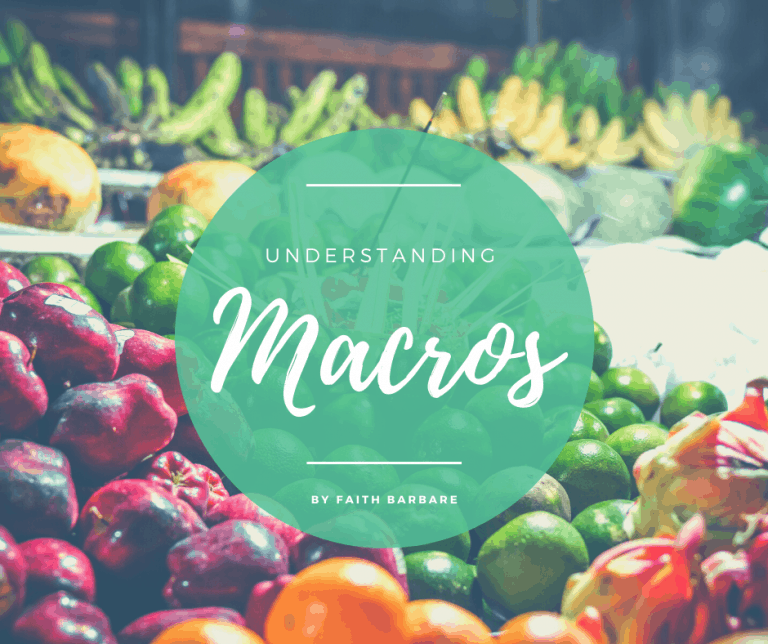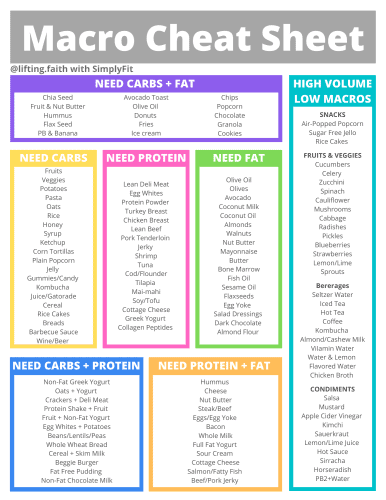
By Faith Barbare, Owner and Certified Personal Trainer and Fitness Nutrition Specialist at SimplyFit
Understanding Macros
With the latest epidemic going around, sticking to a meal plan may not be an option for you right now. Stores are running low on the things you typically need, and who wants to go out in this mess anyways! Understanding what macros are and how you can track them will be a great way to stay on track with your fitness goals, or start them, without stressing in the weeks ahead!
What Are Macros
Macro stands for macronutrients and they are the building blocks of calories. Calories are the unit of measurement used to calculate the energy in the food we eat. There are three types of macros; carbs, protein and fat. Each one has a specific role in keeping our bodies moving.
Carbs are our body’s primary source of energy. There are 4 calories per gram of carbs.
Protein is the most important of the three macros, and it helps build and repair muscle. While in a calorie deficiency, it is important to consume enough protein to help prevent muscle loss. There are 4 calories per gram of protein.
Fats help balance and regulate hormones which is essential for proper brain function. Fats also help us absorb vitamins. Many people think that consuming fat leads to obesity; when in reality, our bodies need a healthy amount. Each gram of fat contains 9 calories.
Don’t forget about our bonus macros – alcohol! It has no nutritional value and carries 7 calories per gram. When tracking, you will need to take this from either your carbs, fat or a combination of the two.
Why Count Macros vs. Calories
Calories determine our body weight and the only way to lose weight is to be in a calorie deficiency. A calorie deficiency means you consume fewer calories than your body burns in a day. However, quantity and quality matter. The quantity, or total calories consumed, determines how much you lose; while the quality, or macros, determines what kind of weight you lose. When losing weight, you want to make sure your body is burning fat and not muscle.
Counting macros is commonly referred to as flexible dieting due to the freedom it brings. Counting macros is sustainable in the long term because it’s less restrictive and allows you to have the foods you enjoy in moderation instead of completely eliminating them.
Typical diets not only increase food cravings, but they also strip away necessary nutrients that our bodies need to function at full capacity. When a diet encourages you to drop an entire macronutrient you’ll often suffer from headaches, fatigue and irritability. It’s often hard for you to give 100% during your workouts when your body feels so drained.
Macros not only help aid in losing weight, but they can also be used to maintain your current weight as well as to gain muscle.
Who Should Count Macros
The best part about counting macros is how customizable they can be. No matter what your dietary restrictions are, you can make flexible dieting work for you and your fitness goals.
If you are new to nutrition or fitness, this might be overwhelming. You may want to start with the USDA’s My Plate to help you learn what a balanced meal looks like and what foods help fuel your body.
If you are someone with a history of an eating disorder, this might not be the right fit for you. While some feel it gives them control, it can become obsessive. If you are struggling with this, please reach out for guidance.
How To Track Your Macros
After figuring out your custom macros (provided in select 6-week challenges) to help achieve your specific health and fitness goals, you’ll want to start tracking your food. To figure out your specific macros, you can buy them here or use a free macro calculator to give you a fair starting point. Keep in mind, macro calculators can sometimes be limiting on the amount of information you can input to calculate your specific macros. Having your macros personalized takes into account your specific goals as well as any health restrictions or guidelines your doctor has laid out for you.
Tracking your macros in an app like MyFitnessPal is important to make sure you’re staying consistent and on track. Oftentimes, we think we are getting enough protein and we are not even close. Tracking allows us to see exactly where calories are coming from and if we are consuming too few or too many; yes, not enough calories is a thing!
When using an app to track meals, it does all the hard work for you. It breaks down how many grams of each macro you’re consuming along with your overall calorie intake. It even shows you just how much you have left throughout the day. Through MyFitnessPal, you can build out recipes and scan items from the grocery store to get the closest numbers possible.
How to Master Tracking
It’s easy to get overwhelmed at first, but the key is to keep trying. You don’t have to be perfect, but the closer you get to your macro goals the closer you are to reaching your long term goals. Here are some helpful ways to really master tracking and to not go crazy!
- Rule of thumb – Stick to around 5 grams under or 5 grams over each macro group. Hitting each one perfectly is next to impossible, so don’t stress if you don’t get there.
- Plan ahead – The more you track the night before, the easier it is to stay on track throughout the day. Here’s a helpful tool when you’re in need of a certain macro to complete your day.
- Weigh your food – It’s time-consuming, but it’s going to give you the most accurate number!
- Be ready to sacrifice – While flexible dieting allows you to have things you love, they still have to be in moderation. If you know a second cookie doesn’t fit in your macros be willing to opt-out and have the carrots instead.
- Stay consistent- Don’t give up after having a bad meal, a bad day or even a bad weekend. Just pick up and start fresh the next day.
- Accountability- No fitness journey is sustainable without accountability. Sometimes holding yourself accountable works, but when that doesn’t, phone a family member or friend. Have them join you on the journey or simply ask them to check in from time to time. Knowing someone is watching can make a world of difference.
Bringing It All Together
While there are so many things to learn about macros, getting a firm understanding of what they are, why they’re important, and how to start tracking them sets you up for success. Learning about them helps you understand the importance of reading food labels and determining what is or isn’t a good fit for your diet.
Nothing worth doing comes easy, and getting it right will take some time. Be willing to learn and stay consistent, and you will get the hang of it in no time!

